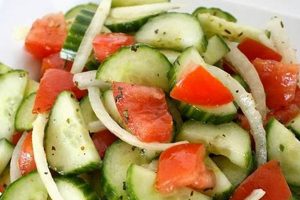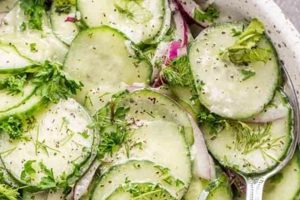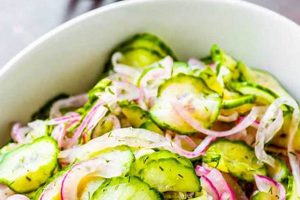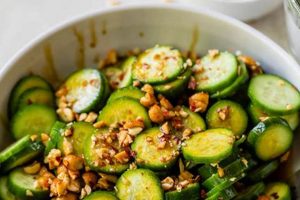A top-tier cucumber salad balances refreshing simplicity with flavorful complexity. A truly exceptional version often involves thinly sliced cucumbers, a vibrant dressing, and carefully chosen complementary ingredients. For instance, a classic preparation might include thinly sliced red onion, fresh dill, and a light vinaigrette made with vinegar, oil, salt, and pepper. Variations can incorporate ingredients like sour cream, yogurt, or different herbs and spices to create unique flavor profiles.
Achieving this balance offers significant culinary advantages. Such a salad provides a light and refreshing counterpoint to richer dishes, making it an ideal side for grilled meats, hearty stews, or spicy cuisine. Historically, cucumbers have been valued for their cooling properties and hydrating benefits, contributing to the enduring popularity of cucumber salads across diverse cultures and throughout culinary history. The adaptability of the cucumber to various flavor combinations has also ensured its continued presence on tables worldwide.
This exploration will delve into various factors that contribute to a superior cucumber salad. Topics will include selecting the optimal cucumber varieties, mastering different slicing techniques, crafting flavorful dressings, and exploring complementary ingredients to enhance the overall culinary experience.
Tips for an Exceptional Cucumber Salad
Creating a truly remarkable cucumber salad involves attention to detail and a thoughtful approach to ingredient selection and preparation. The following tips offer guidance for achieving optimal results.
Tip 1: Choose the Right Cucumber: Select firm, unwaxed cucumbers. English cucumbers are ideal due to their thin skin and minimal seeds. For a different texture, consider Persian cucumbers.
Tip 2: Slice Uniformly: Consistent slicing ensures even marinating and a pleasant texture. Mandolines achieve very thin, uniform slices, while sharp knives allow for more control over thickness.
Tip 3: Salt and Drain Excess Moisture: Salting sliced cucumbers draws out excess water, preventing a watery salad. Allow salted cucumbers to sit in a colander for at least 15 minutes before rinsing and patting dry.
Tip 4: Balance Flavors in the Dressing: A well-balanced dressing complements the cucumber’s delicate flavor. Consider the acidity of vinegar, the richness of oil, and the sweetness or savory notes of additional ingredients.
Tip 5: Incorporate Fresh Herbs: Fresh herbs elevate the flavor profile. Dill, mint, parsley, and chives are excellent choices. Add herbs just before serving to maintain their vibrancy.
Tip 6: Consider Textural Variety: Toasted nuts, seeds, or croutons provide a satisfying crunch. Thinly sliced red onion or crumbled feta cheese can add contrasting flavors and textures.
Tip 7: Chill Before Serving: Chilling allows the flavors to meld and enhances the refreshing quality of the salad. Chill for at least 30 minutes before serving.
By following these guidelines, one can elevate a simple cucumber salad to a culinary highlight. Attention to these details ensures a crisp, flavorful, and refreshing dish.
These techniques, combined with an understanding of flavor profiles and ingredient selection, provide a foundation for culinary excellence in cucumber salad preparation.
1. Fresh, High-Quality Cucumbers
The foundation of an exceptional cucumber salad lies in the selection of fresh, high-quality cucumbers. Subpar produce yields a disappointing result, regardless of other efforts. Understanding cucumber selection is paramount for achieving the desired crispness, flavor, and overall culinary success.
- Variety Selection:
Different cucumber varieties offer distinct characteristics. English cucumbers, known for their thin skin and minimal seeds, are often preferred for salads. Persian cucumbers, smaller and slightly sweeter, present another excellent option. Garden cucumbers, while more readily available, may require peeling and seeding due to thicker skin and larger seed cavities. Choosing the appropriate variety impacts both the texture and flavor of the final dish.
- Signs of Freshness:
Indicators of freshness include firm texture, vibrant green color, and absence of blemishes or soft spots. Avoid cucumbers that appear yellowed, wrinkled, or have a dull appearance. Freshly picked cucumbers offer the best flavor and maintain their crispness in a salad.
- Proper Storage:
Maintaining freshness requires proper storage. Refrigerate cucumbers promptly after purchase and store them unwashed in a perforated plastic bag or wrapped in a paper towel to maintain optimal humidity. Proper storage extends shelf life and preserves quality for optimal salad preparation.
- Organic vs. Conventionally Grown:
While not strictly essential, organic cucumbers offer potential advantages, such as reduced pesticide exposure. Whether organic or conventionally grown, prioritizing freshness and quality remains crucial for a successful salad. Taste and texture should be the primary deciding factors.
Utilizing fresh, high-quality cucumbers forms the cornerstone of a truly exceptional salad. Careful selection, combined with proper storage, ensures that the cucumbers retain optimal crispness, flavor, and contribute to a delightful culinary experience. Overlooking this fundamental aspect compromises the overall quality of the final dish.
2. Precise slicing techniques
Precise slicing techniques are integral to a superior cucumber salad. Uniformity of slices affects not only the aesthetics of the salad but also the texture and flavor absorption. Consistent thickness ensures that each cucumber piece marinates evenly in the dressing, resulting in a harmonious blend of flavors. Thinly sliced cucumbers offer a delicate texture that complements the overall lightness of the salad, while thicker slices provide a more substantial bite. Inconsistent slicing leads to uneven marinating; some pieces may become overly saturated while others remain underdressed, creating an unbalanced flavor profile and a less satisfying textural experience. For instance, paper-thin slices are ideal for a delicate salad with a light vinaigrette, whereas slightly thicker slices might be preferred for a chunkier salad incorporating yogurt or a creamy dressing.
The choice of slicing technique also influences the visual appeal of the salad. Evenly sliced cucumbers create a visually pleasing presentation, enhancing the dining experience. Different slicing methods, such as mandoline slicing, bias cutting, or simple rounds, can further contribute to the aesthetic presentation and textural variation within the salad. A mandoline produces uniformly thin slices, perfect for a delicate salad, while bias cutting adds visual interest and exposes more surface area for flavor absorption. The choice of technique should align with the desired outcome and the overall composition of the salad.
Mastering precise slicing techniques demonstrates attention to detail and elevates the cucumber salad from simple to sophisticated. It is a crucial step that significantly impacts the final product’s flavor, texture, and visual appeal. While seemingly a minor detail, the precision of the slicing technique contributes substantially to the overall quality and enjoyment of a truly exceptional cucumber salad, highlighting the importance of careful preparation in culinary pursuits.
3. Balanced, flavorful dressing
A balanced, flavorful dressing is paramount in elevating a cucumber salad from simple to exceptional. The dressing acts as the unifying element, binding the individual components and imparting depth of flavor that complements the cucumber’s inherent subtlety. A well-crafted dressing enhances the overall sensory experience, transforming the refreshing crunch of cucumber into a culinary delight. The interplay between acidity, sweetness, saltiness, and other flavor notes determines the dressing’s overall impact. An overly acidic dressing can overwhelm the delicate cucumber flavor, while insufficient acidity results in a bland, uninspired salad. Similarly, excessive sweetness detracts from the refreshing quality, and inadequate seasoning leaves the salad tasting flat.
Consider a classic vinaigrette. The balance between vinegar’s sharpness and oil’s richness forms the foundation. A touch of sweetness, perhaps from a drizzle of honey or a pinch of sugar, rounds out the acidity. Salt and freshly ground black pepper provide essential seasoning, enhancing the other flavors. A simple vinaigrette exemplifies the importance of balance; each ingredient contributes to the overall harmony, with no single element dominating the flavor profile. Further complexity can be achieved through additions such as Dijon mustard for tang, minced garlic for pungency, or fresh herbs like dill or mint for aromatic freshness. A creamy dressing, based on yogurt or sour cream, presents a different flavor profile, requiring careful balancing of tangy dairy, herbs, and spices to complement the cucumber’s refreshing nature.
Achieving a harmonious balance within the dressing is crucial for a truly exceptional cucumber salad. The dressing should enhance, not overpower, the cucumber’s delicate flavor. Each ingredient plays a vital role, contributing to a cohesive flavor profile that complements the other components of the salad. Mastering this balance ensures a delightful culinary experience, demonstrating the significant impact of a well-crafted dressing on the overall success of the dish. The understanding of these fundamental flavor principles is essential for creating a cucumber salad that truly stands out.
4. Complementary Ingredient Choices
Complementary ingredient choices distinguish a merely adequate cucumber salad from an exceptional one. These additions provide depth, complexity, and textural contrast, transforming a simple dish into a multi-sensory experience. Thoughtful ingredient selection elevates the cucumber’s delicate flavor, creating a harmonious blend of tastes and textures. The interplay between ingredients is crucial; each addition should enhance, not overpower, the overall composition. For example, the sharp bite of red onion provides a counterpoint to the cucumber’s coolness, while fresh dill or mint introduce aromatic complexity. The creamy tang of feta cheese offers a textural and flavor contrast, while toasted sesame seeds contribute a nutty crunch. These seemingly minor additions significantly impact the final product’s overall quality and appeal.
Consider the practical application of this principle. A Mediterranean-inspired cucumber salad might incorporate Kalamata olives, crumbled feta cheese, and a lemon-herb vinaigrette. The saltiness of the olives, the tang of the feta, and the bright citrus notes of the dressing harmonize beautifully with the cucumber’s refreshing nature. Alternatively, an Asian-inspired version could feature thinly sliced red chili, toasted sesame seeds, and a rice vinegar-based dressing, creating a dynamic interplay of spicy, nutty, and tangy flavors that complement the cucumber’s subtle sweetness. These examples illustrate how carefully chosen complementary ingredients elevate a basic cucumber salad into a sophisticated and flavorful dish.
Understanding the significance of complementary ingredients unlocks the potential for culinary creativity and elevates cucumber salad preparation to an art form. Strategic ingredient selection, based on flavor profiles, textures, and cultural influences, dramatically impacts the final product’s overall appeal and culinary merit. Successfully integrating complementary ingredients demonstrates a nuanced understanding of flavor balance and enhances the sensory experience of a seemingly simple dish, transforming it into a culinary masterpiece. The careful consideration of these additions is essential for crafting a truly remarkable cucumber salad.
5. Proper salting and draining
Proper salting and draining is a crucial step in achieving a best cucumber salad recipe. Cucumbers possess high water content. Without this essential preparatory step, excess moisture leaches into the salad, diluting the dressing and creating a watery, unappetizing final product. Salting the sliced cucumbers draws out this excess moisture through osmosis. The salt creates a hypertonic environment, causing water to move out of the cucumber cells and onto the surface, where it can be easily drained away. This process ensures a crisper, more flavorful salad with a dressing that adheres properly to the cucumber slices rather than becoming diluted. Omitting this step compromises the overall quality, resulting in a less satisfying culinary experience.
Consider a scenario where a cucumber salad is prepared without salting and draining. The accumulated liquid pools at the bottom of the serving dish, diluting the carefully crafted dressing. The cucumbers themselves become soggy and lose their crisp texture. The overall flavor profile is weakened, and the salad becomes less appealing. Conversely, a properly salted and drained cucumber salad retains its crispness, the dressing maintains its intended flavor integrity, and the overall presentation remains visually appealing. The difference is stark and underscores the importance of this often-overlooked step. For example, a classic cucumber and dill salad benefits significantly from salting and draining; the delicate dill flavor is not masked by excess water, and the cucumbers maintain a pleasant crunch. This technique also proves essential in salads incorporating creamy dressings, preventing the dressing from becoming thin and watery.
Mastery of this technique significantly impacts the final result. It demonstrates a fundamental understanding of culinary principles and elevates the cucumber salad from mediocre to excellent. While seemingly simple, proper salting and draining directly influences the texture, flavor, and overall presentation of the dish. Neglecting this crucial step compromises the quality and diminishes the enjoyment of the final product, highlighting the importance of attention to detail in achieving culinary excellence. The seemingly small effort required for this process yields significant rewards in terms of flavor and texture, contributing substantially to the overall success of a best cucumber salad recipe.
6. Effective chilling duration
Effective chilling duration plays a crucial role in achieving a best cucumber salad recipe. Temperature and time influence flavor development and textural integrity. Proper chilling allows the flavors of the dressing and other ingredients to meld harmoniously with the cucumbers, resulting in a more cohesive and balanced flavor profile. Furthermore, chilling enhances the refreshing quality of the salad, making it particularly appealing in warmer weather. Insufficient chilling results in a less flavorful and less refreshing salad, while excessive chilling can compromise the texture, making the cucumbers mushy.
- Flavor Enhancement:
Chilling allows the flavors of the various componentscucumbers, dressing, and other ingredientsto meld and deepen. Similar to marinating, the low temperature slows down chemical reactions, allowing a more gradual and nuanced flavor development. For example, the subtle sweetness of the cucumbers balances more effectively with the acidity of the vinaigrette after a period of chilling, creating a more harmonious flavor profile. A chilled salad offers a more integrated and complex flavor experience compared to a freshly prepared one.
- Texture Preservation:
Optimal chilling preserves the crisp texture of the cucumbers, a key characteristic of a refreshing salad. Cold temperatures firm the cucumber’s cell structure, maintaining desirable crispness. However, excessive chilling can damage cell walls, leading to a mushy texture. Finding the right balance between temperature and duration is crucial. A perfectly chilled cucumber retains a satisfying crunch, enhancing the overall enjoyment of the salad.
- Refreshment Factor:
A chilled cucumber salad offers a heightened sense of refreshment, particularly desirable in warm weather. The cool temperature provides a welcome contrast to heat, enhancing the sensory experience. A room-temperature cucumber salad, while palatable, lacks the invigorating quality of a properly chilled one. This cooling effect contributes significantly to the overall appeal and enjoyment of the dish.
- Food Safety:
Proper chilling also contributes to food safety. Lower temperatures inhibit bacterial growth, extending the salad’s shelf life and reducing the risk of foodborne illness. Maintaining a safe temperature range during preparation and storage is crucial for preserving the quality and ensuring the safe consumption of the cucumber salad.
The chilling duration, therefore, is not merely a matter of preference but a critical factor influencing the overall quality and enjoyment of a best cucumber salad recipe. It represents a delicate balance between flavor development, texture preservation, refreshment, and food safety. Proper chilling elevates the simple combination of cucumbers and dressing into a truly satisfying and refreshing culinary experience, highlighting the importance of temperature control in achieving optimal results.
7. Creative Flavor Combinations
Creative flavor combinations distinguish exceptional cucumber salads from ordinary ones. While simplicity can be a virtue, innovative pairings elevate this classic dish, transforming it into a culinary adventure. Exploring diverse flavor profiles unlocks the cucumber’s full potential, showcasing its versatility and adaptability. This exploration delves into the multifaceted nature of flavor combinations within the context of a best cucumber salad recipe.
- Cultural Influences:
Drawing inspiration from global cuisines provides a rich source of creative flavor combinations. A Japanese-inspired salad might incorporate mirin, soy sauce, sesame oil, and ginger, creating a savory-sweet umami profile. Conversely, a Mediterranean approach could utilize feta cheese, olives, oregano, and a lemon vinaigrette, highlighting bright, briny, and herbaceous notes. Integrating cultural influences expands the possibilities beyond traditional preparations, introducing novel and exciting flavor dimensions.
- Balancing Flavor Profiles:
A successful cucumber salad balances contrasting yet complementary flavors. The cucumber’s mild, refreshing character provides a neutral canvas for various flavor combinations. Balancing acidity, sweetness, saltiness, spiciness, and umami is key. For instance, the sweetness of honey or maple syrup can temper the sharpness of vinegar, while the heat of chili flakes can be balanced by the cooling properties of yogurt or mint. A well-balanced flavor profile ensures a harmonious and satisfying culinary experience.
- Textural Variety:
Texture plays a crucial role alongside flavor. Incorporating ingredients with contrasting textures adds complexity and interest. Toasted nuts or seeds provide crunch, while creamy cheeses or avocado contribute richness and smoothness. The cucumber’s inherent crispness provides a refreshing counterpoint to these additions. Consider a salad with toasted sesame seeds and crumbled feta cheese; the interplay of textures enhances the overall sensory experience.
- Seasonal Adaptations:
Adapting flavor combinations to seasonal ingredients ensures optimal freshness and flavor. Summer salads might feature ripe tomatoes, fresh basil, and a light vinaigrette, highlighting the season’s bounty. In contrast, a fall-inspired salad could incorporate roasted squash, toasted pecans, and a maple-balsamic vinaigrette, reflecting the flavors of autumn. Utilizing seasonal ingredients maximizes flavor intensity and adds an element of culinary creativity.
Creative flavor combinations are the hallmark of a truly exceptional cucumber salad. By thoughtfully combining ingredients and balancing flavor profiles, textures, and seasonal influences, one transforms a simple dish into a culinary masterpiece. The potential for experimentation is vast, limited only by culinary imagination. Embracing creativity in flavor combinations elevates the cucumber salad experience, showcasing the versatility of this humble vegetable and creating a dish that is both refreshing and deeply satisfying.
Frequently Asked Questions
This section addresses common inquiries regarding optimal cucumber salad preparation, offering practical solutions and clarifying potential misconceptions.
Question 1: How can one prevent a watery cucumber salad?
Salting the sliced cucumbers and allowing them to drain for at least 15 minutes prior to dressing draws out excess moisture, preventing a watery consistency. Thorough drying with a clean towel further aids in moisture removal.
Question 2: What type of cucumber is best suited for salad preparation?
English cucumbers are often preferred due to their thin skin and minimal seeds. Persian cucumbers also offer excellent flavor and texture. Garden cucumbers can be used but may require peeling and seeding.
Question 3: What are effective strategies for enhancing the flavor of a simple cucumber salad?
Fresh herbs, such as dill, mint, or parsley, elevate flavor profiles. Complementary ingredients, including thinly sliced red onion, crumbled feta cheese, or toasted nuts, introduce textural and flavor complexity.
Question 4: How long should a cucumber salad be chilled before serving?
Chilling for at least 30 minutes allows flavors to meld and enhances the refreshing quality. However, avoid excessive chilling, as it can compromise the cucumber’s texture.
Question 5: Can cucumber salad be prepared in advance?
While best served fresh, cucumber salad can be prepared a few hours in advance. Store the dressed salad in an airtight container in the refrigerator. Add delicate herbs just before serving to maintain their vibrancy.
Question 6: What are some alternatives to traditional vinegar-based dressings?
Creamy dressings, such as those based on yogurt or sour cream, offer a different flavor profile. Asian-inspired dressings utilizing sesame oil, rice vinegar, and soy sauce provide another alternative.
Addressing these common questions provides a comprehensive understanding of the nuances of cucumber salad preparation. Attention to detail in each step ensures a crisp, flavorful, and refreshing culinary experience.
This information provides a foundation for crafting exceptional cucumber salads. Further exploration of specific recipes and techniques allows for personalized culinary expression.
Crafting the Best Cucumber Salad Recipe
Culinary excellence in cucumber salad preparation relies on a confluence of factors. From the selection of fresh, high-quality cucumbers to the nuanced balance of a flavorful dressing, each element contributes significantly to the final product. Precise slicing techniques, proper salting and draining, effective chilling, and the thoughtful incorporation of complementary ingredients further enhance the overall sensory experience. Exploration of diverse flavor combinations expands culinary horizons, demonstrating the cucumber’s remarkable versatility. Attention to these details elevates a seemingly simple dish into a culinary masterpiece, showcasing the transformative power of careful preparation and thoughtful ingredient selection.
The pursuit of a truly exceptional cucumber salad represents a continuous journey of culinary discovery. An understanding of fundamental principles combined with creative exploration allows for personalized adaptations and flavor innovations. This pursuit encourages culinary experimentation, fostering a deeper appreciation for the nuances of flavor and texture, ultimately enriching the culinary landscape.






